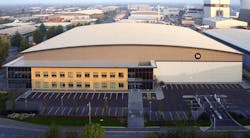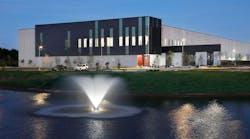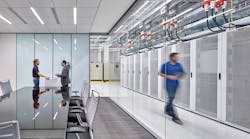Some data center acquisitions are motivated by the need to add more capacity. Others are driven by the addition of revenue from existing tenants. In a growing number of deals, the goal is to add both income and future capacity.
That’s the case for the latest deal in the UK market, in which Equinix is acquiring UK’s data center operating business in Slough. The facility, which will be renamed LD10, is just around the corner from Equinix’s existing data center campus in Slough, a major data center hub about 20 miles west of London. The IO facility houses 350 cabinets of IT gear for existing customers, with a tenant mix that maps closely to Equinix’s existing base of financial services firms, enterprises, and network providers.
The IO Slough data center also has room for an additional 3,000 cabinets. That’s a lot of upside for Equinix, which says the additional space will help it meet growing demand for digital infrastructure connectivity in the United Kingdom and Europe. The new LD10 site will be tethered to the three existing data centers (LD4, LD5, LD6) on the Equinix Slough campus, enabling customers the ability to interconnect with one another and gain low-latency connectivity to key markets.
“London remains a global economic engine, with leading enterprises and cloud service providers making it a primary hub for IT infrastructure,” said Eric Schwartz, president, EMEA, Equinix. “Adding additional interconnection and capacity in this market enables local and international customers to leverage Platform Equinix to meet their changing business needs – whether that is to connect to networks, clouds, or financial markets.”
More Modules, or Equinization?
The Equinix-IO deal aligns with an M&A strategy that balances risk and reward. Buying a facility with tenants in place provides revenue, while retaining an “upside” from leasing the empty space. It’s a model that has proven popular with companies like Lincoln Rackhouse, Central Colo, T5 Data Centers, H5 Data Centers and ByteGrid, among others.
What’s not immediately clear is the approach Equinix will take to building out the remainder of LD10. The IT equipment at IO UK’s facility is housed in BASELAYER Anytime data center modules.
IO has been a pioneer in the market for modular data centers, designing and building pre-fabricated, factory-built enclosures to create an enclosed data hall that looks and feels like traditional data center space. In 2014, IO spun off BASELAYER to handle global sales of module data centers.
Equinix says it will use the BASELAYER modules to help existing customers “maintain and expand” their equipment as needed. IO’s deployment model is quite different from the design used by Equinix, which is the world’s largest colocation provider, operating 10 million square feet of data center space in 147 facilities spread across 40 countries.
Different designs: Data center deployments inside data centers for IO/BASELAYER (left) and Equinix (right).
Equinix has long been known for housing equipment on a slab floor, introducing cool air into the data hall from overhead ducts rather than through a raised floor. Last year the company updated its data center design to feature indirect evaporative cooling, an approach that uses cool outside temperature to support the cooling system, but doesn’t introduce fresh air directly into the data hall.
Equinix hasn’t made a decision on how it will deploy capacity at LD10 going forward. “We just acquired the facility on Friday so our engineering teams are still working on how we integrate the BASELAYER infrastructure into our global operating platform,” said an Equinix spokesperson.
Already A Busy Year for M&A
The deal continues an ongoing consolidation for the data center industry, in which Equinix has been one of the leading acquirers, expanding its scale and geographic footprint. In 2016 the company began the year with a $3.8 billion acquisition of the Telecity Group, and closed the year with a $3.6 billion acquisition of a portfolio of Verizon data centers.
The early weeks of 2017 have seen the torrid pace of deals continue. In January there were eight significant acquisitions of companies or facilities, highlight the industry’s growing focus on regional markets. On Feb. 2, private equity firm Steonepeak Infrastructure Partners acquired colocation specialist Cologix, and on Feb. 6 CyrusOne paid $490 million to buy two facilities from Sentinel Data Centers.






